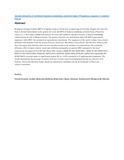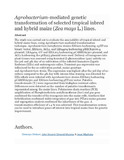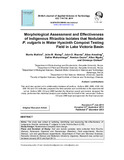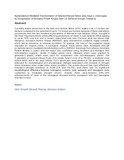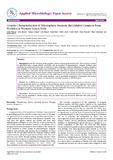Search
Now showing items 1-10 of 15
Effects of Water Hyacinth (Eichhornia crassipes [mart.] solms) Compost on Growth and Yield Parameters of Maize (Zea mays)
(British Journal of Applied Science & Technology, 2013-11-18)
Aims: To evaluate the effects of water hyacinth compost prepared with various cultures
on growth and yield parameters of maize. Study Design: Randomized Complete Block Design. Place and Duration of Study: Field experiments ...
Genetic diversity of symbiotic bacteria nodulating common bean (Phaseolus vulgaris) in western Kenya
(Plos One, 2018-11-15)
Biological nitrogen fixation (BNF) in legumes plays a critical role in improving soil fertility. Despite this vital role, there is limited information on the genetic diversity and BNF of bacteria nodulating common bean ...
Agrobacterium-mediated genetic transformation of selected tropical inbred and hybrid maize (Zea mays L.) lines.
(Plant Cell, Tissue and Organ Culture (PCTOC), 2012-10-25)
The study was carried out to evaluate the amenability of tropical inbred and hybrid maize lines, using Agrobacterium mediated transformation technique. Agrobacterium tumefaciens strains EHA101 harbouring a pTF102 binary ...
Morphological Assessment and Effectiveness of Indigenous Rhizobia Isolates that Nodulate P. vulgaris in Water Hyacinth Compost Testing Field in Lake Victoria Basin
(Current Journal of Applied Science and Technology, 2013-12-05)
Aims: The study was aimed at isolating, identifying and assessing the effectiveness of indigenous rhizobia nodulating P. vulgaris in Lake Victoria Basin (LVB).
Study Design: Randomized complete block design.
Place and ...
Agronomic effectiveness of water hyacinth-based composts
(African Journal of Agricultural Research, 2018-09)
Because water hyacinth-based compost contains substantial amounts of nitrogen (N), phosphorus (P) and potassium (K) its application can boost crop production. We evaluated the agronomic performance of water hyacinth - based ...
Effects of Water Hyacinth (Eichhornia crassipes [mart.] solms) Compost on Growth and Yield Parameters of Maize (Zea mays
(Current Journal of Applied Science and Technology, 2013-11-18)
Aims: To evaluate the effects of water hyacinth compost prepared with various cultures on growth and yield parameters of maize.
Study Design: Randomized Complete Block Design.
Place and Duration of Study: Field experiments ...
Improving Water Hyacinth-Based Compost for Crop Production
(Journal of Agricultural Science and Food Technology, 2018-05-30)
A study was carried out to hasten maturity, improve nutrient content and determine agronomic performance of
water hyacinth-based composts. Water hyacinth (WH) was composted using pile method and six treatments:
WH + ...
Agrobacterium-Mediated Transformation of Selected Kenyan Maize (Zea mays L.) Genotypes by Introgression of Nicotiana Protein Kinase (npk1) to Enhance Drought Tolerance
(American Journal of Plant Sciences, 2014-03)
Currently maize production in the East and Central Africa (ECA) region is at 1.3 tonnes per hectare compared to the potential of up to 7.0 tonnes per hectare because of biotic and abiotic constraints, and this has resulted ...
Genetic Characterization of Rhizosphere Bacteria that Inhabit Common Bean Nodules in Western Kenya Soils
(Applied Microbiology: open access, 2017-03)
Background: With the increasing world population, there is increasing demand for food. This has led to overuse of agricultural farms causing reduced soil fertility and accumulation of phytopathogens. Inorganic fertilizers ...
Belowground Influence of Rhizobium Inoculant and Water Hyacinth Composts on Yellow Bean Infested by Aphis fabae and Colletotrichum lindemuthianum under Field Conditions
(Journal of Plant Studies, 2016-04)
Rhizobium inoculant has been developed for bean production in Lake Victoria basin. Two types of compost have been developed, water hyacinth compost with cattle manure culture (H+CMC) or with effective microbes (H+EM). ...


